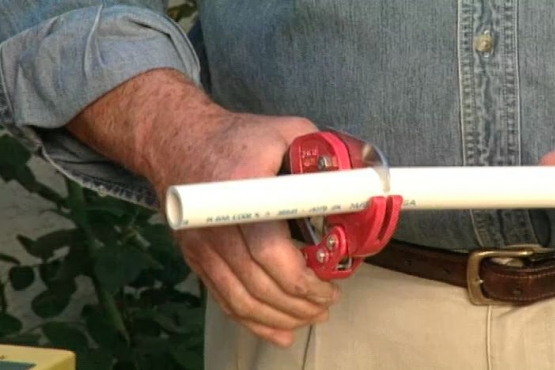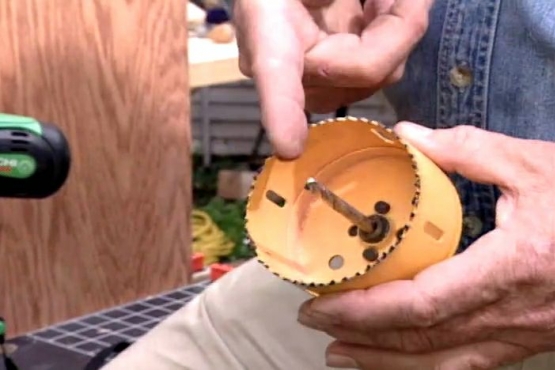RON HAZELTON:
You know until recently I'd never thought much about having a central vacuum system. But once I began considering the advantages, noise reduction, convenience and cleaner air, I started warming up to the idea. And finally decided to put one in.
Well, actually I guess it might have been the stairs that convinced my wife Lynn and I of the merits of a central vac.
Hey Chris, how are ya? Come on in, buddy.
For this project I teamed up with Chris Ellis, an installer for Cyclone Home Systems in nearby Newington, CT, a dealer for Beam Central Vacuums.
So Chris, I really hope you can do this without opening up the walls.
Because I just went through that with a sprinkler and I don't want to do that again. Now the concept behind the central vac is fairly straightforward.
The motor and filter for a central vacuum system are located in an out-of-the-way place like the garage, or, in our case, the basement.
PVC plastic pipe is run from the power unit to outlets throughout the house. We’re going to want them everywhere from the attic to the basement. That’s four floors.
Is there a way to get from the basement up?
CHRIS ELLIS:
Well typically, we like to look for closets that line up from the first floor to the second floor. And that will allow us access to run the pipe.
RON HAZELTON:
We've got one here. When you say line up, what do you mean?
CHRIS ELLIS:
Well, from the second floor to the first floor and that will allow us to run a pipe.
[BOTH SPEAK AT ONCE]
RON HAZELTON:
That isn't gonna work here. There's no closet on top of this. In fact, there are only two closets on this floor, on this level.
CHRIS ELLIS:
Okay.
RON HAZELTON:
But I do have a laundry chute here. And this goes up to the second floor. I'm not sure where it goes from there. But I could show you where the other end of this is.
CHRIS ELLIS:
All right.
RON HAZELTON:
Okay. All right. Up here is the top. Okay, so here it is. What do you think?
CHRIS ELLIS:
Yeah, looks good.
RON HAZELTON:
So this is gonna be a way we can get the pipe from the basement clear up to the attic without having to open the wall, right.
CHRIS ELLIS:
Definitely, I think so.
RON HAZELTON:
Good. That's really good news.
Well that’s a relief to me. Chris collects his tools and a bundle of plastic pipe and we begin by drilling a hole through the bottom of the laundry chute and into the basement.
CHRIS ELLIS:
All right, I'll pull it out.
RON HAZELTON:
Yeah pull it out. Okay I'm coming back up at you with a hole saw now.
CHRIS ELLIS:
All right.
RON HAZELTON:
You okay?
CHRIS ELLIS:
Yeah, it looks good.
RON HAZELTON:
Okay, I'm coming up.
I know the laundry chute goes all the way up to the second floor. However, I need to run the pipe into the partially finished attic above. So Chris and I cut out a portion of the attic floor in search of the top of the chute.
Okay, grab the flashlight there.
CHRIS ELLIS:
All right.
RON HAZELTON:
Shine it down there. Yeah, I think that's the top of our laundry chute right there. So what do you think Chris? Why don't you go down -we'll go down and sort of drill a hole up through the top of that. I'll watch from here and be sure that we are in the right spot.
You see it.
CHRIS ELLIS:
Yeah.
RON HAZELTON:
Okay you're through. Can you see me? Can you see me?
CHRIS ELLIS:
Yeah, I see light.
RON HAZELTON:
To make sure the holes are aligned, I drop a plumb bob all the way from the attic into the basement.
Now we have a way to get the pipe from the power unit up to the attic. From the attic, the plan is to run pipe downward inside the walls to reach the outlets on the second floor. We’re almost through the top plate of the wall when …
CHRIS:
There's so many nails and screws -
[BOTH SPEAK AT ONCE]
RON HAZELTON:
I don't believe this - well Murphy is at work again. We've drilled into a veritable minefield of nails and screws. So we're left with no choice but to move over and try again.
[BOTH SPEAK AT ONCE]
RON HAZELTON:
You through?
CHRIS ELLIS:
Yeah.
RON HAZELTON:
All right, you want to clean it out with a hole saw.
CHRIS ELLIS:
Yeah, we can do that. Make it nice and clean.
RON HAZELTON:
Okay.
With a clean hole at the top, Chris goes down to the second floor and pushes a screwdriver through the wall where we've planned to locate the outlet.
[BOTH SPEAK AT ONCE]
CHRIS ELLIS:
- up there.
RON HAZELTON:
I check the alignment from above. It looks good. So Chris marks and cuts out the opening for the outlet.
CHRIS ELLIS:
All right, it's cut.
RON HAZELTON:
I want to drop a plumb bob down here, okay? I'm gonna put it in the center of the hole. It's sitting up in the middle of the cutout. Just check it.
CHRIS ELLIS:
I got it.
RON HAZELTON:
Okay, Chris, are you ready for the wire?
CHRIS ELLIS:
I'm ready.
RON HAZELTON:
Okay, I'm sending it down.
This low voltage wire will run all the way back to the power unit. When the hose is plugged in, the wire will carry a signal that turns on the vacuum. Chris connects an elbow to the back plate, inserts the plate into the wall, then attaches the cover with a couple of screws.
So what's happening, this is the fixture you've got right here in the wall of the master bedroom, right?
CHRIS ELLIS:
That's right.
RON HAZELTON:
And that piece you're dropping down in is gonna fit right in this L.
CHRIS ELLIS:
Yeah. Right in there, snug.
RON HAZELTON:
And you're gonna - you're gonna drop that in from up here. Just like so.
CHRIS ELLIS:
That's it.
RON HAZELTON:
So this is the pipe coming up out of the bedroom. Crosses over here. Now we're ready to go all the way down to the basement, right.
CHRIS ELLIS:
That's right.
RON HAZELTON:
Okay. Start by running the wire.
CHRIS ELLIS:
Yeah, run the wire.
RON HAZELTON:
Okay. I'm just gonna go down through the second floor. Coming up on the first floor, okay. Now we're into the basement. What's next?
CHRIS ELLIS:
Well, next we'll run some pipe. Yeah, why don't you go on the second floor - I'll fish this to you.
RON HAZELTON:
Chris lowers the PVC pipe inside the laundry chute from the attic to the second floor, to the first floor and into the basement. We repeat this process for another outlet in a second floor hallway. To install the first-floor outlets, Chris drills holes from the basement up inside the walls, cuts an opening and installs the low voltage wire and outlet fixture…attaches the cover plate … then feeds the PVC pipe up from below to make the connection. Well, we've installed a total of six outlets. One in the attic, two on the second floor, two on the first floor and one in the basement. All pipe runs lead to one place: the central vacuum power unit.
Okay so I've got - I just walk from room to room with this, set it down and do my cleaning, huh?
CHRIS ELLIS:
That's right.
RON HAZELTON:
It's just one big vacuum. Okay, I'm on the -on the bracket here.
CHRIS ELLIS:
All right.
RON HAZELTON:
Once the power unit's hung on the wall, all that's left for us to do is connect the piping. Now what's this over here?
CHRIS ELLIS:
That's the muffler system.
RON HAZELTON:
I have a muffler?
CHRIS ELLIS:
Oh yeah.
RON HAZELTON:
Quiet as a mouse.
CHRIS ELLIS:
Very quiet.
RON HAZELTON:
Are you hooked up over there?
CHRIS ELLIS:
I'm all hooked up.
RON HAZELTON:
Okay, I'm gonna turn it on and see. This is it, right.
[SOUND OF VACUUM]
You know what they say, a clean house is a happy house.
RON HAZELTON:
All of our outlets have been located near electrical receptacles so that we can easily plug in the cord for the power head. Now I won't say a central vacuum will turn housework into play, but a system like this can deliver a lot of suction very quietly. And make navigating around a house like this a heck of a lot easier.








